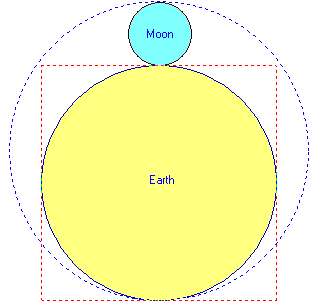This is the first in a series I hope to post on the oddities of our solar system
" ... An intriguing fact is the ratio between the Earth's outer orbit and Venus' inner orbit is given by a square.

Venus Perihelion: 107,476,259 km (0.718 432 70 AU)
Earth Aphelion: 152,098,232 km (1.01671388 AU)
152098232 / 107476259 = 1.4151798 (Perfect is 1.4142135)
Let me share with you other facts about cosmic harmony. The radius of the Moon compared to the Earth is three to eleven, ie. 3:11.
Radius of Moon = 1,080 miles = 3 x 360
(Answer:
1738.14 km = 1080.030 mi. OR 1080 mi. and 53.01 yd )
Radius of Earth = 3,960 miles = 11 x 360 = 33 x 1 x 2 x 3 x 4 x 5
(Answer: 6378.1 km = 3963.167 mi. OR 3963 mi. and 294.9 yd )
Radius of Earth plus Radius of Moon = 5,040 miles = 1 x 2 x 3 x 4 x 5 x 6 x 7 = 7 x 8 x 9 x 10
(Actual 5043.197 miles )
The ratio 3:11 is 27.3 percent, and the orbit of the Moon takes 27.3 days.
(Sidereal rotation period 27.321582 d (synchronous)
27.3 days is also the average rotation period of a sunspot.
(Sunspot populations quickly rise and more slowly fall on an irregular cycle of 11 years, although significant variations in the number of sunspots attending the
11-year period are known over longer spans of time. For example, from 1900 to the 1960s the solar maxima trend of sunspot count has been upward; from the 1960s to the present, it has diminished somewhat. Over the last decades the Sun has had a markedly high average level of sunspot activity; it was last similarly active over
8,000 years ago.
Solar Rotation. The mean sidereal rotation period is 25.38 days (the Carrington period).
The corresponding synodic rotation period is 27.2753 days. The sidereal period is the rotation period as viewed from a fixed point in space whereas the synodic period is the rotation period as viewed from Earth (and thus is used when calculating heliographic coordinates). [
www.petermeadows.com]
The closest : farthest distance ratio that Venus and Mars each experiences in the Mars-Venus dance is incredibly 3:11. The Earth orbits between them. Couldn't prove this but what I did find will astound you.
Venus Aphelion: 108,942,109 km
Earth Semi major Axis = 149598261 km
(149598261 / 11) x 8 = 108,798,735 It appears that the furthest reaches of Venus' orbit is in the ratio of 8:11 to Earth's average distance from The Sun and if the above is correct then making up the other 3/11 we have this: The closest : farthest distance ratio that Venus and Mars each experiences in the Mars-Venus dance is incredibly 3:11. The Earth orbits between them.
The sizes of the Moon and the Earth 'Square the Circle' as shown in this illustration, which is drawn to scale. The perimeters of the dotted square and the dotted circle are the same length.

The perimeter of the dotted red square is 4 x Earth's diameter = 4 x 7,920 miles = 31,680 miles.
The circumference of the dotted blue circle is 2 pi x radius = 2 x 3.142 x 5040 miles = 31,667 miles. (ie. 99.9%) "
[
ensign.editme.com]
Article by Howard Arrington
"There is nothing as impenetrable as a closed mind"
and ..." if everything is a coincidence what is the point of studying or measuring or analyzing anything ?" db
Edited 4 time(s). Last edit at 01/12/2011 07:47PM by Ahatmose.




